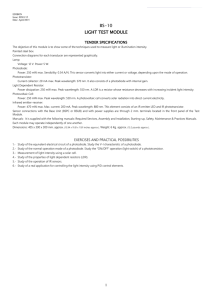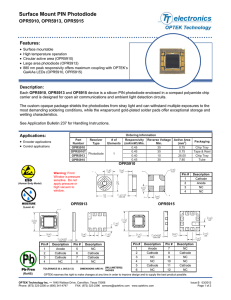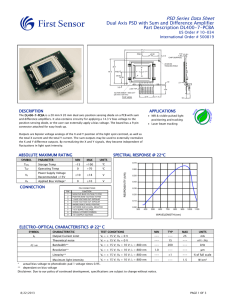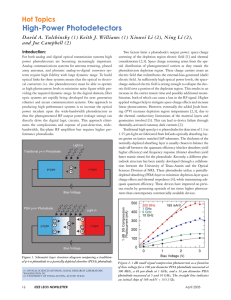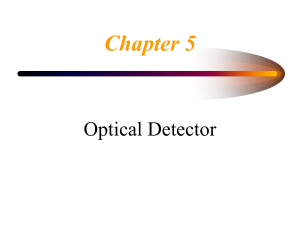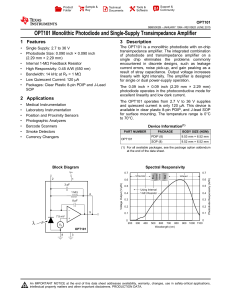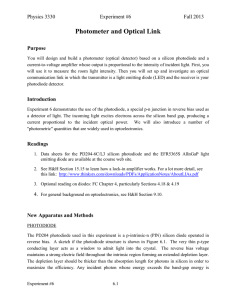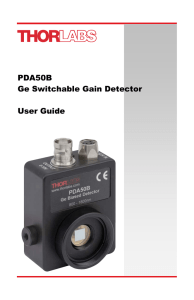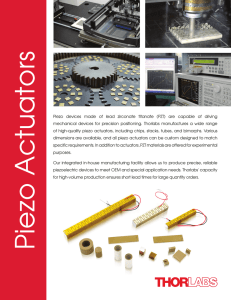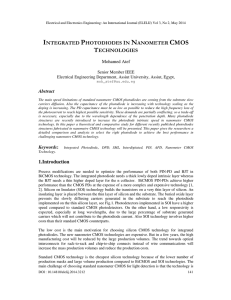Photodiode
advertisement
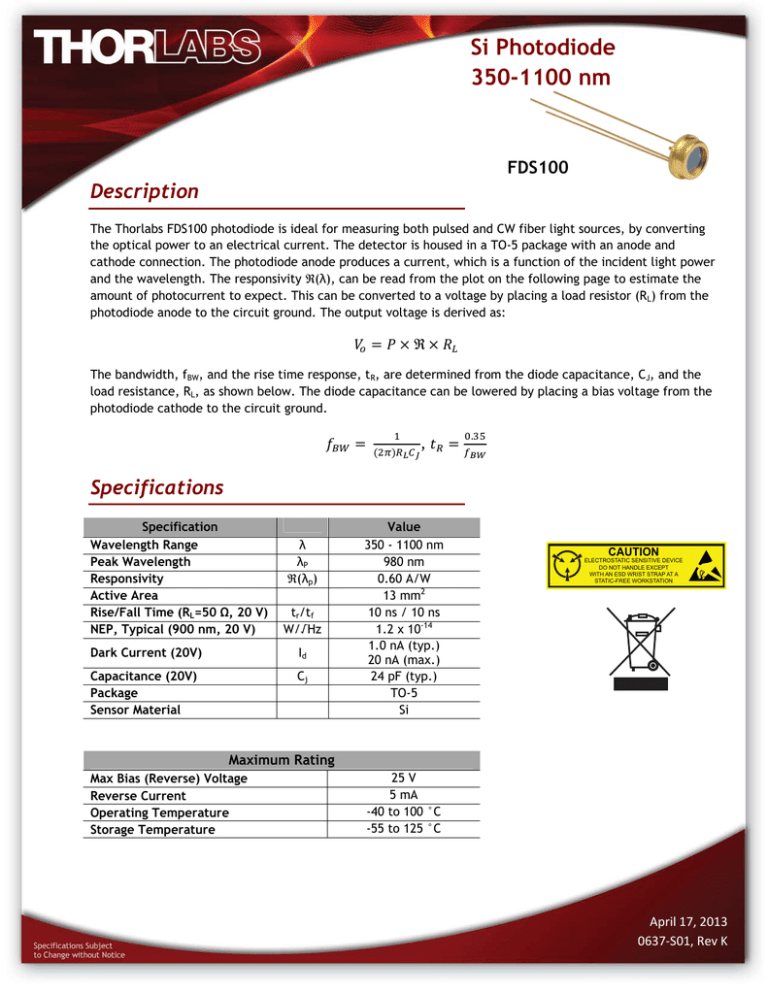
Si Photodiode 350-1100 nm FDS100 Description The Thorlabs FDS100 photodiode is ideal for measuring both pulsed and CW fiber light sources, by converting the optical power to an electrical current. The detector is housed in a TO-5 package with an anode and cathode connection. The photodiode anode produces a current, which is a function of the incident light power and the wavelength. The responsivity ℜ(λ), can be read from the plot on the following page to estimate the amount of photocurrent to expect. This can be converted to a voltage by placing a load resistor (RL) from the photodiode anode to the circuit ground. The output voltage is derived as: = ×ℜ× The bandwidth, fBW, and the rise time response, tR, are determined from the diode capacitance, CJ, and the load resistance, RL, as shown below. The diode capacitance can be lowered by placing a bias voltage from the photodiode cathode to the circuit ground. = , = . Specifications Specification Wavelength Range Peak Wavelength Responsivity Active Area Rise/Fall Time (RL=50 Ω, 20 V) NEP, Typical (900 nm, 20 V) λ λP ℜ(λp) tr/tf W/√Hz Dark Current (20V) Id Capacitance (20V) Package Sensor Material Cj Value 350 - 1100 nm 980 nm 0.60 A/W 13 mm2 10 ns / 10 ns 1.2 x 10-14 1.0 nA (typ.) 20 nA (max.) 24 pF (typ.) TO-5 Si CAUTION ELECTROSTATIC SENSITIVE DEVICE DO NOT HANDLE EXCEPT WITH AN ESD WRIST STRAP AT A STATIC-FREE WORKSTATION Maximum Rating Max Bias (Reverse) Voltage Reverse Current Operating Temperature Storage Temperature 25 V 5 mA -40 to 100 °C -55 to 125 °C April 17, 2013 0637-S01, Rev K Typiccal Specttral Inte ensity Diistributiion The respo onsivity of a photodiode p is a measure of its sensitivitty to light and d is defined as the ratio of the photocurrent IP to the inciden nt light powerr P at a given wavelength: = In other words, w it is a measure of the effectiven ness of the co onversion of llight power in nto electricall current. Responsiv vity varies fro om lot to lot and a with the wavelength o of the inciden nt light, applied reverse b bias, and temperature. It increa ases slightly with w applied reverse r bias d due to improvved charge co ollection efficciency in the photodiod de. The chang ge in tempera ature increasses or decreasses the width h of the band gap and varies inversely with the temperature. t . Sp pectral Res sponse 0.7 Responsivity (A/W) 0.6 0.5 0.4 0.3 0.2 0.1 0 300 400 4 500 600 700 800 900 0 1000 11 100 Wavelengtth (nm) Recom mmended d Circuiit Noise e Filter + Bias Voltage - + PD R1 = 1 kΩ Ω RL C1 = 0.1 0 μF * Vo * Case ground for PD witth a third lead. April 17, 201 13 0 0637-S01, Rev vK Drawing Top View Side View Ø8.3 mm (Ø0.33") 10.2 mm (0.40") 3.5 mm (0.14") 3.6 mm (0.14") Ø5.8 mm (Ø0.23") 2.0 mm (0.08") 1.0 mm (0.04") 38.1 mm (1.50") Ø9.1 mm (Ø0.36") 3.6 mm (0.14") Bottom View Pin 3 Pin 3 Pin 2 Ø0.4 mm (Ø0.02") Ground Pin 2 Pin 1 Pin 1 Precautions and Warranty Information These products are ESD (electro static discharge) sensitive and as a result are not covered under warranty. In order to ensure the proper functioning of a photodiode care must be given to maintain the highest standards of compliance to the maximum electrical specifications when handling such devices. The photodiodes are particularly sensitive to any value that exceeds the absolute maximum ratings of the product. Any applied voltage in excess of the maximum specification will cause damage and possible complete failure to the product. The user must use handling procedures that prevent any electro static discharges or other voltage surges when handling or using these devices. Thorlabs, Inc. Life Support and Military Use Application Policy is stated below: THORLABS’ PRODUCTS ARE NOT AUTHORIZED FOR USE AS CRITICAL COMPONENTS IN LIFE SUPPORT DEVICES OR SYSTEMS OR IN ANY MILITARY APPLICATION WITHOUT THE EXPRESS WRITTEN APPROVAL OF THE PRESIDENT OF THORLABS, INC. As used herein: 1. Life support devices or systems are devices or systems which, (a) are intended for surgical implant into the body, or (b) support or sustain life, and whose failure to perform, when properly used in accordance with instructions for use provided in the labeling, can be reasonably expected to result in a significant injury to the user. 2. A critical component is any component in a life support device or system whose failure to perform can be reasonably expected to cause the failure of the life support device or system or to affect its safety or effectiveness. 3. The Thorlabs products described in this document are not intended nor warranted for usage in Military Applications. April 17, 2013 0637-S01, Rev K
